The onset of a journey into the world of drone racing can be as thrilling as the races themselves. For the uninitiated enthusiast looking to delve into this high-octane hobby, drafting the blueprint to Building Your First Racing Drone marks a critical milestone. It is where technology, skill, and the thrill of first-person flight converge, creating a pulsating experience like no other. This is your quintessential Beginner Drone Racing Guide, designed to demystify the complexities and unfold the exhilarating process of a DIY Drone Build.
Every racing drone pilot knows that the real joy lies in not just the races, but also in the art of crafting their aerial steed. With this guide, we aim to offer insight into the foundational Drone Racing Techniques that will enable you to construct a drone that’s not simply ready to fly, but ready to compete. Engage in this absorbing pastime and emerge with the knowledge to not only build but also pilot your winged racer with confidence.
Introduction to FPV Drone Racing
The sport of FPV (First Person View) drone racing is a high-adrenaline, technologically advanced competition that combines speed, precision, and pilot skill. This rapidly growing sport has garnered a dedicated following, entranced by the thrill of piloting drones through intricate courses. Aspiring pilots need to delve into the essentials of Racing Drone Assembly, pick up crucial Drone Racing Tips, and meticulous Racing Drone Set Up to stay competitive in this challenging field.
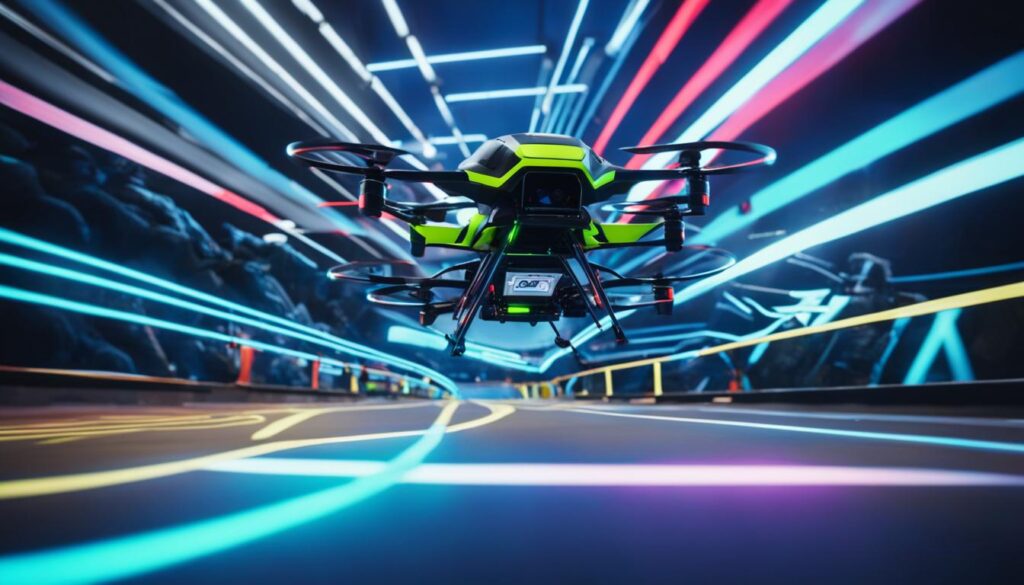
What FPV Racing Entails
FPV racing challenges pilots to fly their drones through complex air courses, deftly maneuvering around obstacles at high velocity. The experience is akin to a high-speed aerial obstacle course that tests both the capabilities of the drone and the reflexes of the pilot. Achieving success in FPV racing requires a mix of technical knowhow and the ability to make split-second decisions while navigating a thrilling three-dimensional racetrack.
Comparing Freestyle, Cinematic, and Racing Drones
| Drone Type | Primary Focus | Speed | Maneuverability | Typical Use Case |
|---|---|---|---|---|
| Racing Drones | Speed and Competition | High | Very High | Competitive Races |
| Freestyle Drones | Creativity and Tricks | Moderate | High | Aerial Acrobatics |
| Cinematic Drones | Camera Quality and Smooth Flight | Lower | Moderate | Filmmaking and Content Creation |
Embracing the Thrill of First-Person View
FPV drone racing invokes an exhilarating sense of immersion, as pilots view the world from the drone’s perspective, soaring through the skies at impressive speeds. Embracing this remarkable thrill requires not only a passion for flight but also a dedication to understanding the mechanics and electronics of FPV drones. The enthusiasts who master the art of Racing Drone Assembly and finesse their Racing Drone Set Up are the ones who truly experience the incredible rush of FPV racing.
Building Your First Racing Drone
Embarking on the adventure of constructing a racing drone can be as exciting as the race itself. Each piece of the aerial puzzle must be chosen with purpose and insight, fitting together to create a machine that is both resilient and efficient in its operation. With our actionable drone racing tips and a focus on essential racing drone components, even beginners can navigate the process with confidence and emerge with a high-performance drone primed for the thrill of racing.
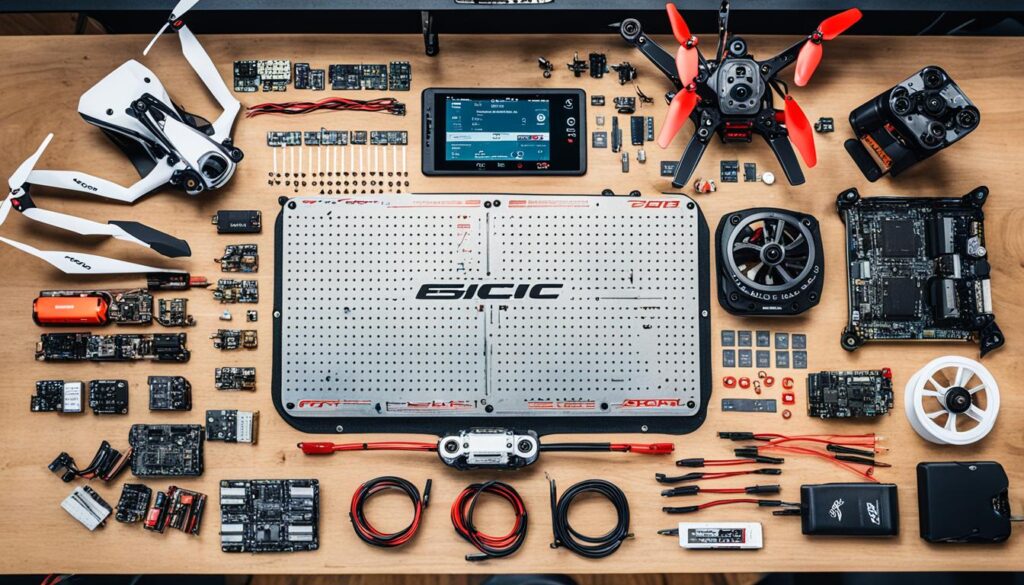
Before the propellers can whirl and the engines roar, a sturdy frame must be selected. This foundational component is vital for holding all other parts in place and must be able to withstand the inevitable impacts of racing. Materials such as carbon fiber provide an optimal balance of strength and weight, ensuring your drone is durable and agile in the skies.
Upon setting the foundation, the assembly of the flight system commences. This system is a symphony of components, each playing a critical role in the drone’s performance. Understanding the interaction between motors, Electronic Speed Controllers (ESC), propellers, receiver, and the flight controller is central to building a drone that responds intuitively to your commands and excels in competition.
| Component | Function | Specification Tips |
|---|---|---|
| Frame | Supports all components and withstands impacts | Choose lightweight, strong materials like carbon fiber |
| Motors | Provides thrust to the drone | Opt for brushless motors for better power and durability |
| ESC | Controls the speed of the motors | Ensure compatibility with your motors for smooth operation |
| Propellers | Generates lift and maneuverability | Select based on desired balance of thrust and agility |
| Receiver | Receives instructions from the remote control | Must be compatible with your transmitter and responsive |
| Flight Controller | Maintains stability and directs flight dynamics | Look for one with advanced gyroscopes and software capability |
Finally, the integration of the FPV system finalizes your drone build. An FPV camera and a Video Transmitter (VTX) form the eyes and voice of your racing drone, casting real-time visuals to your goggles and immersing you in the heart-pounding action of the race.
Whether you’re soldering the ESCs, calibrating the flight controller, or securing the propellers, remember that each step is a learning experience, teaching you the nuances of aerial dynamics and engineering. With each component meticulously selected and assembled, you are not just building a drone; you’re crafting an extension of your will to race, to fly, and to triumph.
Choosing the Right Racing Drone Components
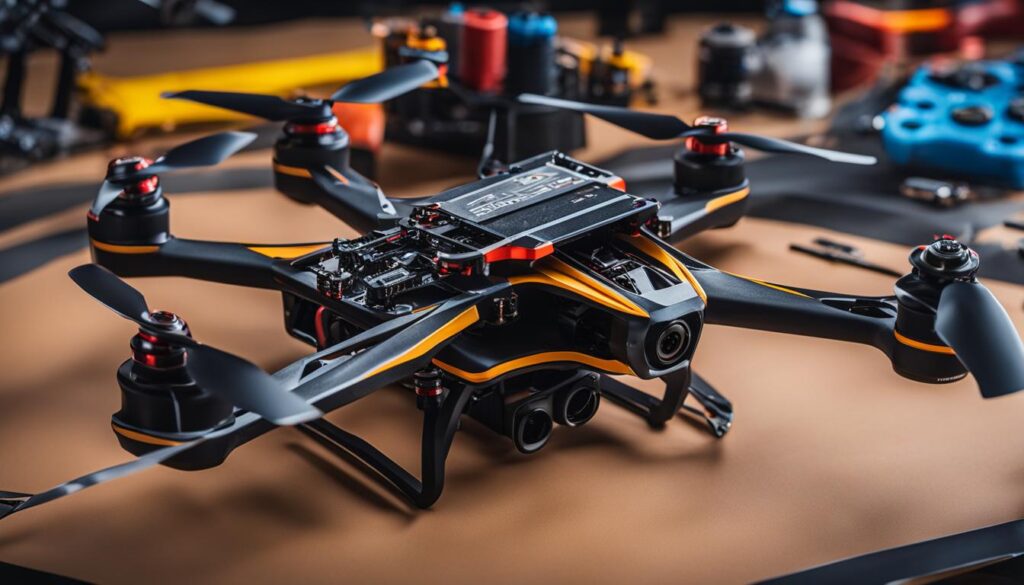
For those passionate about drone racing techniques, constructing a racing drone that can dominate the skies starts with the meticulous selection of racing drone components. The art of racing drone assembly combines precision with performance, and everything begins with the foundations: sturdy frames and premium materials. Venture into the assembly process with informed choices and tailor your drone to your racing dreams.
Understanding Frames and Materials
When it comes down to frames, the integral skeleton of your drone, the right choice is synonymous with resilience. Carbon fiber stands out as a prevalent material, offering both durability and a streamlined design for those adrenaline-fueled competitions. Let’s examine the attributes that make a frame not just a part of the drone, but the defining factor in its racing capabilities.
Selecting Motors, ESCs, and Propellers
The heart of drone performance lies in its motors, Electronic Speed Controllers (ESCs), and propellers. Brushless motors are renowned for their rapid response and high RPM capabilities, essential for high-stakes racing. The propeller selection can dramatically influence the agility and aerodynamics of your drone, while ESCs fine-tune the motor power, delivering seamless thrust control. Pairing the right motors with the perfect propellers and ESCs could be the difference between victory and defeat.
The Importance of Flight Controllers and Receivers
The flight controller is the brain of the operation, assimilating pilot commands and external sensor data to achieve an unsurpassed equilibrium mid-flight. In conjunction with a compatible receiver, this system ensures the essential connection between pilot and machine is robust and reactionary. To succeed in the fast-paced arena of drone racing, your choices in these technologies must underscore speed, stability, and precision.
| Component | Function | Importance |
|---|---|---|
| Frame | Structural Foundation | Provides durability and defines the drone’s architecture |
| Motor | Generates Propulsion | Crucial for thrust and in-flight agility |
| ESC | Motor Power Regulation | Smooths and controls the power delivered to the motors |
| Propeller | Creates Lift and Thrust | Directly affects flight characteristics and efficiency |
| Flight Controller | Stabilization and Command Processing | Central to maintaining stability and responsiveness |
| Receiver | Wireless Communication | Ensures seamless connection between the drone and the pilot’s inputs |
The convergence of components in racing drone assembly dictates not just the success of a build but the potential for triumph in the field. Employ these insights to craft a drone that not only meets the technological standards of competitive drone racing but exceeds the expectations set by passion and the pursuit of aerial excellence.
The FPV System Explained
At the heart of the immersive experience of drone racing is the FPV System, a critical assembly that enables pilots to feel as if they are soaring through the sky aboard their drones. This system not only revolutionizes the control of drones but also the viewing experience, allowing pilots to employ advanced Drone Racing Techniques for precise maneuvering and navigation during high-octane races.
Central to the system is the FPV camera which captures the action from the point of view of the drone, serving as the eyes of the pilot. This camera’s feed is swiftly transmitted by a powerful Video Transmitter, piercing through the air to the pilot’s FPV goggles, turning a typical remote-controlled drone into a vessel for racing experiences that are as close to flying as one can get without wings.
Drone enthusiasts often find themselves choosing between digital and analog setups for their Racing Drone Set Up. Each type offers unique benefits which cater to different preferences and racing scenarios. Here is a closer look:
| Analog FPV System | Digital FPV System |
|---|---|
| Lower latency for real-time response | Higher video quality with crisp images |
| More affordable option | Robust signal less prone to interference |
| Wider range of component compatibility | Enhanced pilot immersion with detailed visuals |
| Lightweight and power-efficient | Advanced features such as audience viewing |
Furthermore, for an even richer recount of the racing experience, pilots often augment their FPV cameras with high-definition recording cameras like GoPros, which offer stunning video quality perfect for sharing and revisiting one’s aerobatic prowess.
“That split-second decision in the midst of a drone race, the adrenaline-fueled turns, and the triumphant crossing of a finish gate; these are the moments a racing pilot lives for, and the FPV System is what makes it a lived reality.”
Understanding the nuances of setting up a precise FPV System is key to success in the dynamic sport of drone racing. It’s not just about the thrill; it’s about the connection between pilot and drone, the seamless integration of man and machine that only a state-of-the-art FPV System can facilitate.
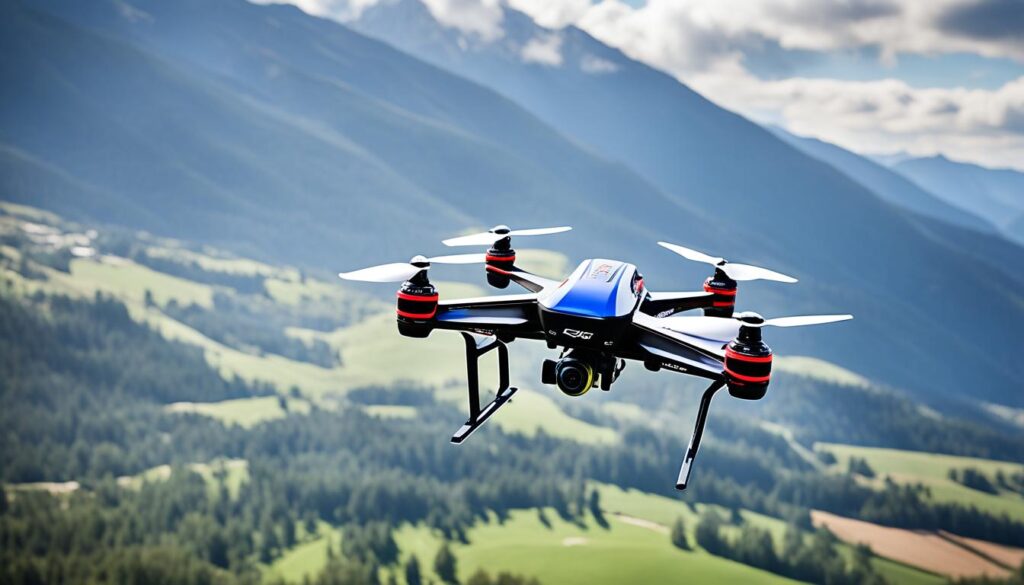
In closing, as you venture into the realm of FPV drone racing, may the FPV System be your guide and gateway to mastering the skies. It isn’t simply about racing; it’s about becoming one with your drone and igniting a passion for flight that knows no bounds. Embrace the system, master the techniques, and fly beyond the horizon of exhilaration.
Drone Assembly Tips and Techniques
Embarking on a DIY Drone Build can be a transformative adventure, bridging the gap between concept and skyward acrobatics. The pathway to constructing a resilient racing drone is strewn with bits and bolts, circuitry and controllers. When you begin, the importance of laying out each segment before assembly cannot be overstated. This thoughtful preparation, aligning with expert Drone Assembly Tips, solidifies the journey’s progression – from a tableau of parts to a symphony of flight.
Step-by-Step Assembly Process
Implement a methodical assembly process to ensure that every component fits perfectly into its designated place. Begin with the structural integrity of the frame and gently graduate to the intricacies of the flight system, culminating in the integration of the FPV system. By approaching this step-by-step, the overall Racing Drone Set Up becomes less daunting, allowing for a smooth transition into the precise world of drone racing.
Soldering and Wiring Best Practices
Soldering requires a steady hand and a keen eye for detail, with each joint holding the potential to elevate or hinder the performance of your racing drone. Practice refined soldering techniques to foster strong electrical connections. Remember, an organized assembly is an effective one; well-routed wires neaten your build, simplifying future upgrades and repairs. Perception in this stage is pivotal; the clearer the setup, the simpler the solution when addressing any electrical anomalies.
Testing and Troubleshooting
Once the assembly is complete, rigorous testing ensures that performance aligns with potential. Testing encompasses everything from propeller alignment to responsive FPV feed, creating a fusion of technology and tenacity. In the event discrepancies arise, troubleshooting becomes a learning curve, encapsulating safety and performance as twin priorities. The result of thorough testing and adept troubleshooting is a racing drone that stands ready – a vessel of velocity primed for the skies.
FAQ
Q: What do I need to know before building my first racing drone?
A: Before embarking on your journey to build a racing drone, it’s crucial to understand the fundamentals of FPV racing, the importance of each drone component, and the skills required for soldering and assembling the parts. Additionally, being familiar with different flying techniques and the specific regulations for drone racing can greatly enhance your building and racing experience.
Q: What are the key components of a racing drone?
A: The essential components of a racing drone include the frame, motors, Electronic Speed Controllers (ESCs), propellers, a flight controller, a receiver, and an FPV system comprising a camera, a Video Transmitter (VTX), and FPV goggles for the pilot.
Q: How does FPV racing differ from FPV freestyle and cinematic flying?
A: FPV racing is a competitive sport focused on speed and precision navigation through challenging racecourses. FPV freestyle is more about creativity and executing complex aerial maneuvers, while cinematic FPV aims at capturing smooth, high-quality footage for a visually stunning experience. Each discipline requires different drone setups and flying techniques.
Q: What materials are racing drone frames usually made of, and why?
A: Racing drone frames are typically constructed from carbon fiber due to its high strength-to-weight ratio, durability, and resistance to impact. This material ensures that the drone can withstand the rigors and crashes commonly experienced during high-speed racing.
Q: How do I choose the right motors and propellers for my drone?
A: When selecting motors and propellers, consider the size, thrust, efficiency, and response rates that match your racing style and the demands of the courses you will navigate. High-performance brushless motors paired with well-chosen propellers can provide the necessary agility and speed for competitive racing.
Q: Why is the flight controller considered the ‘brain’ of the racing drone?
A: The flight controller is responsible for processing the pilot’s inputs and sensor data to stabilize the drone and execute precise maneuvers. It is the central component that manages the dynamics of flight and keeps the drone balanced and responsive during races.
Q: What is an FPV system, and how does it enhance drone racing?
A: An FPV (First Person View) system includes an FPV camera, a video transmitter, and FPV goggles. It allows the pilot to see what the drone sees in real-time, creating an immersive experience and enabling precise navigation through the racing course as if the pilot were in the cockpit of the drone.
Q: What are the advantages of building my own racing drone over buying a pre-built one?
A: Building your own racing drone offers a deeper understanding of its mechanics and customizability to suit your racing style. It also empowers you with the knowledge to perform repairs and upgrades, which is invaluable in a hobby where crashes and technical adjustments are frequent.
Q: Can you describe the basic steps of assembling a racing drone?
A: Assembling a racing drone involves laying out and verifying all parts, securely attaching components to the frame, precise soldering of electronic parts, organizing cables for functionality, and systematically connecting the flight system and FPV components. Once assembled, thorough testing and troubleshooting are essential to ensure optimal performance.
Q: What are some common issues I might encounter during my first drone build, and how can they be resolved?
A: Common issues include poor solder joints, incorrect wiring, and compatibility problems between components. These can be resolved by practicing soldering techniques, carefully following wiring diagrams, and ensuring all parts are designed to work together. Patience and attention to detail during assembly can prevent many of these issues.
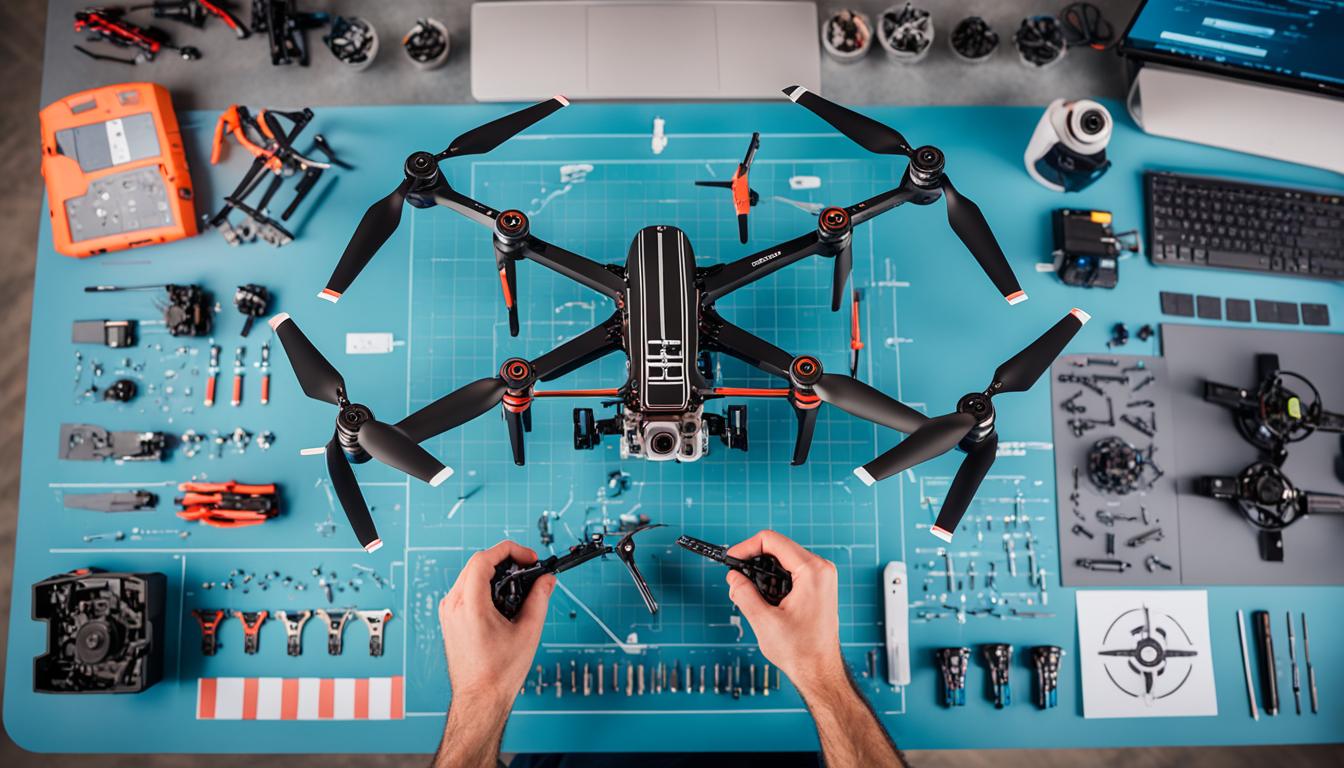
Leave a Reply